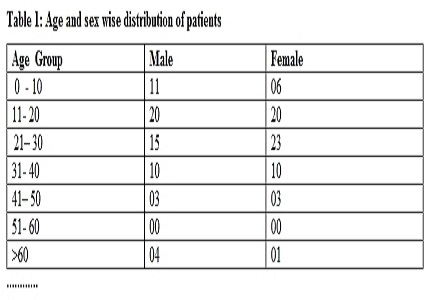Hematological profile in typhoid fever
Abstract
Introduction: Typhoid fever is an acute infection of the blood and intestinal system caused by the bacterium Salmonella typhi. In India S. typhi and S.paratyphi are the common agents of enteric fever. Complications of these lesions are hemorrhage and intestinal perforation. Carrier state is common and bacilli are found in blood, feces and urine. As there is massive multiplication of bacilli in blood stream, this paper aims to study the frequency and severity of hematological changes in patients of typhoid fever with special reference to thrombocytopenia.
Methodology: This study was a hospital based descriptive study conducted on OPD and IPD patients of LLR Hospital Kanpur who presented to Emergency Pathology Lab, GSVM Medical College Kanpur. The study design was cross sectional. Study was designed to include demographics, clinical information and hematological changes observed in each patient of typhoid fever using widal test or positive culture. The data was analyzed to study the changes in hematological parameters in these patients.
Result: The study revealed the sex ratio to be almost unity and maximum cases were seen in 11-20 year age group. Thrombocytopenia was observed in a significant 39.7% and leucopenia in 11.6% of cases. Mean PCV was reduced to 29.6% and mean neutropil percentage was reduced to28% and mean lymphocyte percentage of was 59% showed relative lymphocytosis.
Conclusion: Typhoid fever causes significant hematological changes which could be helpful in diagnosis. Thrombocytopenia is common in typhoid but this association is not well recognized. Awareness of this associate on could be useful in diagnosis of typoid fever more so in under resourced endemic regions in developing countries
Downloads
References
Okafor A I.Haematological alterations due to typoid fever in Enugu Urban- Nigeria. Malaysian Journal of Microbiology.2007;3(2): 19-22.
Ifeanyi OE. Changes in some haematological parameters in typhoid patients attending University Health Services Department of Michael Okpara University of Agriculture, Nigeria. Int. J.Crr. Microbiol. App. Sci 2014; 3(1):670 -674
Yaramis A, Yildirim I, Katar S, Ozbek MN, Yalcin I, Tas M et al. Clinical and Laboratory Presentation of Typhoid fever. International Pediatrics.2001;16(4): 227 – 231.
B. M. K. Cheong. Typhoid Fever Presenting as Acute Cerebellar Ataxia and severe Thrombocytopenia. The Medical Journal of Malaysia. 2008; 63 (1): 77-78.
Chiu CH, Tsai JR, Ou JT, Lin TY. Typhoid fever in children: a fourteen-year experience. Acta Paediatr Taiwan. 2000 Jan-Feb;41(1):28-32.
Chow CB, Wang PS, Cheung MW, Yan WW, Leung NK. Diagnostic value of the Widal test in childhood typhoid fever. Pediatr Infect Dis J. 1987 Oct;6(10):914-7.
Parry CM, Hoa NT, Diep TS, Wain J, Chinh NT, Vinh H, Hien TT, White NJ, Farrar JJ. Value of a single-tube widal test in diagnosis of typhoid fever in Vietnam. J Clin Microbiol. 1999 Sep;37(9):2882-6.
Akgun Y, Bac B, Boylu S, Aban N, Tacyildiz I. Typhoid enteric perforation. Br J Surg. 1995 Nov;82(11):1512-5.
Khalili Matinzadeh Z. . Leucopenia and Thrombocytopenia in typhoid fever and a case report. Journal of Sabzevar School of Medical Sciences.2001; 3(21)): 83 – 87.
Yap PK, Chua CT. The haemogram in the diagnosis of acute typhoid fever--with special reference to thrombocytopenia. Singapore Med J. 1983 Jun;24(3):161-2.
Malik AS, Malik RH. Typhoid fever in Malaysian children. Med J Malaysia. 2001 Dec;56(4):478-90.
Serefhanoglu K, Kaya E, Sevinc A, Aydogdu I, Kuku I, Ersoy Y. Isolated thrombocytopenia: the presenting finding of typhoid fever. Clin Lab Haematol. 2003 Feb;25(1):63-5.
Khosla SN, Anand A, Singh U, Khosla A. Haematological profile in typhoid fever. Trop Doct. 1995 Oct;25(4):156-8.
Wichmann O, Stark K, Shu PY, Niedrig M, Frank C, Huang JH, Jelinek T. Clinical features and pitfalls in the laboratory diagnosis of dengue in travellers. BMC Infect Dis. 2006 Jul 21;6:120.



 OAI - Open Archives Initiative
OAI - Open Archives Initiative


